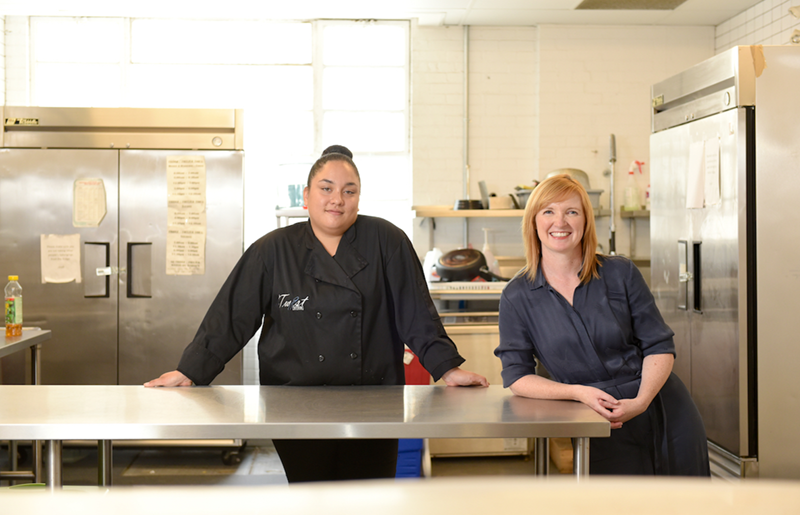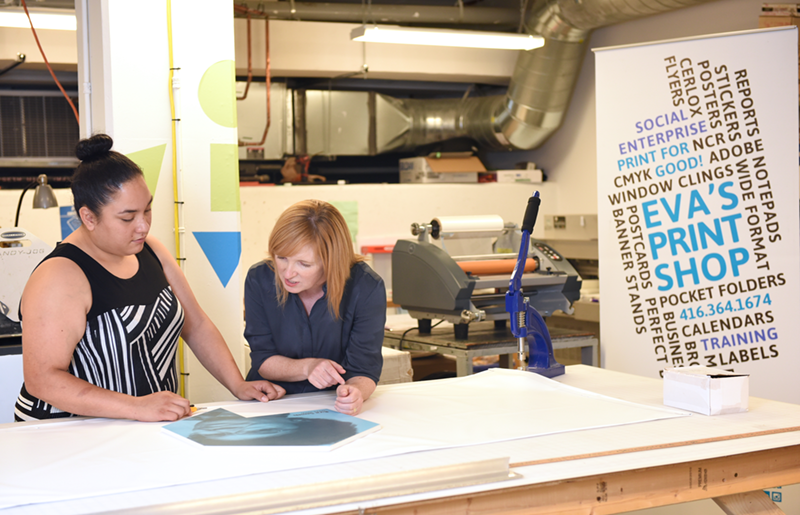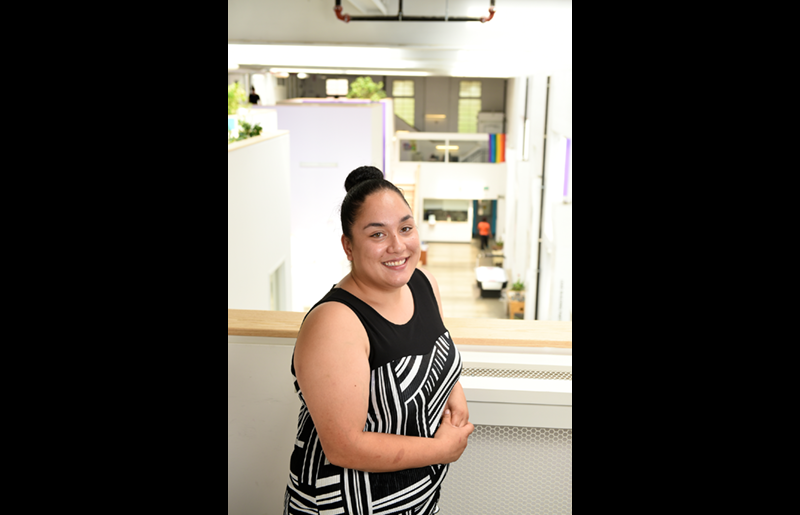 Youth learn valuable cooking skills in the kitchen at Eva’s Phoenix site
in downtown Toronto. Shown here: Louise Smith, interim executive director
of Eva’s and Kristen Szekszardi, lab participant and former client of
Eva’s.
Youth learn valuable cooking skills in the kitchen at Eva’s Phoenix site
in downtown Toronto. Shown here: Louise Smith, interim executive director
of Eva’s and Kristen Szekszardi, lab participant and former client of
Eva’s.
 The print shop at Eva’s Phoenix site in downtown Toronto is an innovative
social enterprise. It provides service to local businesses and valuable
job training for youth. Shown here: Louise Smith, interim executive
director of Eva’s, and Kristen Szekszardi, peer researcher and former
client of Eva’s.
The print shop at Eva’s Phoenix site in downtown Toronto is an innovative
social enterprise. It provides service to local businesses and valuable
job training for youth. Shown here: Louise Smith, interim executive
director of Eva’s, and Kristen Szekszardi, peer researcher and former
client of Eva’s.
 Kristen Szekszardi overlooking the common area of Eva’s Phoenix site in
downtown Toronto.
Kristen Szekszardi overlooking the common area of Eva’s Phoenix site in
downtown Toronto.
November 4, 2019
Mapping Solutions to Youth Homelessness, Charting a Brighter Future
More than 500 youth take refuge in Toronto shelters every single day, including the transitional and emergency shelters operated by Eva’s Initiatives for Homeless Youth. Similar journeys take place in Montreal, Vancouver and other major urban centres across Canada.
Large-scale studies on homelessness exist, but they don’t give a sense of the migration patterns that bring young people to shelters. For example, the path racialized youth take to homelessness is different from those moving to the city from rural areas.
A better understanding of these patterns could lead to better programs and policies.
Eva’s Initiatives, a youth organization in Toronto, is conducting a solutions lab that is mapping youths’ journeys in & out of #homelessness, developing promising prototypes and solutions that support them along their journey.
Journeys In and Out is delivering a solutions lab that aims to fill this knowledge gap and recommend prototype solutions. It’s being led by Eva’s, which marks its 25th year of providing innovative housing solutions for youth in Toronto.
“Young people can become homeless because of a trauma, like a family breakdown, immigration issues, abuse, or issues related to coming out as LGBQT+,” says Eva’s interim director, Louise Smith. “So on top of housing, they need many different supports. This project will help us learn what young people need and develop solutions as to how they can more quickly exit homelessness and find more stability.”
Kristen Szekszardi, a team member for the solution lab, was once a client of Eva’s. She understands firsthand the importance of getting the right help at the right time.
“For young people, practical supports aren’t enough,” says Kristen. “They need emotional support and relationships – not one-off connections. They need someone to take the time to get to know what will best help them, whether that’s harm reduction, mental health services, or job training.”
Kristen and other team members worked with design firm Deloitte Doblin to create a toolkit to guide in-depth interviews. Using Eva’s services, 25 youth at different stages in their journey in and out of homelessness can share their experiences. They will map the various housing situations that brought them to the shelter and the acts of resiliency or solutions that have served them well so far.
What is learned from the youth is crucial to recommending solutions. Just as important is what they learn about themselves. According to Kay Dyson Tam, the project manager, “We’re taking an innovative approach that encourages them to create their own narrative – be their own superhero in their story by highlighting their strengths and resiliency.”
Kristen appreciates the lab’s resiliency-based approach. She recognizes that her own homelessness journey has given her strengths and skills that she now brings to this project. “I know how to connect with the youth participating in the lab and I can relate to their stories,” she explains. “Like them, I once made my way to this shelter, and now I’m working in Eva’s Head Office. I have a job to do and it gives me purpose.”
The lab team will be working with renowned experts in the field of youth homelessness, including Dr. Vikki Reynolds and Dr. Kaitlin Schwan. They will combine the interview data with formal academic studies to gain a better understanding of gaps in service, systems and research.
This enables them to create a map of macro trends. The team can then prototype recommendations for governments and service providers whose policies and programs affect the homeless youth in Toronto. The ultimate goal will be implementing the recommendations in Montreal, Vancouver and other large Canadian cities.
Journeys In and Out received funding from CMHC’s Solutions Lab, a National Housing Strategy initiative. Eva’s Initiatives for Homeless Youth is leading the project in collaboration with research partner York University’s The Canadian Observatory on Homelessness, service providers Pacific Community Resources Society in Vancouver and Dans La Rue in Montreal. Deloitte Doblin has been an important partner throughout the project. They have been key to preparing the project proposal, co-designing sessions, and creating the interview toolkit creation. They have also been fundamental to carrying data analysis and visualization, and creating the prototype roadmap to scale solutions.
More information NHS Project Profile

